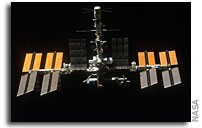NASA Space Station Lead Increment Scientist’s Highlights For the Week of May 07, 2012

(Highlights: Week of May 07, 2012) — Ground teams successfully performed vision characterization activities for Robonaut 2 by saving images of the machine vision cameras — high-definition cameras in the head — at various positions. Controllers also ran a script where Robonaut performed switch-throws and button presses on a taskboard. Robonaut not only looks like a human, but it also is designed to work like one. With human-like hands and arms, Robonaut is able to use the same tools station crew members use. In the future, the greatest benefits of humanoid robots in space may be as assistants for astronauts during spacewalks.
Operations continued for the Burning And Suppression of Solids (BASS) investigation. BASS examines the burning and extinction characteristics of a wide variety of fuel samples in microgravity. A crew member conducted three test points where each test obtained a flame, which led to useful observations and data gathering. The BASS investigation will guide strategies for extinguishing accidental fires in microgravity. BASS results contribute to the combustion computational models used in the design of fire detection and suppression systems in microgravity and on Earth.
Through the end of Expedition 30, the Crew Earth Observation (CEO) team received 223,609 of the CEO frames for review and cataloging. For this investigation, station crew members photograph natural and human-made changes on Earth. These images provide researchers with key data to better understand the planet.
The International Space Station Agricultural Camera (ISSAC) imaged three stretch targets within its primary science region, and one additional target near the coast of Greenland. The intent is to image an iceberg near the Greenland coast, and characterize the ability of ISSAC to analyze environmental change. ISSAC also imaged 40 strip targets for a total of 3,446 images that spanned 68,920 kilometers. These targets were primarily focused on the Northern Plains region of the United States, however two of these targets were taken off the coast of Newfoundland, in order to determine the camera’s feasibility in studying coastal climate change.
Crew members made successful contact with the Mariner’s Museum in Newport News, Va., and St. Paul, Minn., as part of the International Space Station HAM Radio (ISS HAM Radio) investigation. For the Newport News event, there were about 280 attendees who joined via video teleconference from four locations: Virginia, Minnesota, New York and Louisiana. By utilizing ham radios, this investigation gets students interested in space exploration by allowing them to talk directly with the crews living and working aboard the space station.
A crew member began the Astronaut’s Energy Requirements for Long-Term Space Flight (Energy) experiment by consuming a standardized breakfast, measuring water intake, performing several oxygen uptake measurements using the Pulmonary Function System and collecting urine. This European Space Agency physiology investigation is aimed at measuring changes in energy balance in crew members following long duration spaceflight. Energy also will measure adaptations in the components of the total energy expenditure of astronauts to derive an equation for the energy requirements of astronauts.
Human research investigations continued for various crew members including, Integrated Cardiovascular, Sprint, Treadmill Kinematics, Integrated Immune, Journals, Reaction Self Test, and VO2Max.
John Love, Lead Increment Scientist Expedition 30/31








